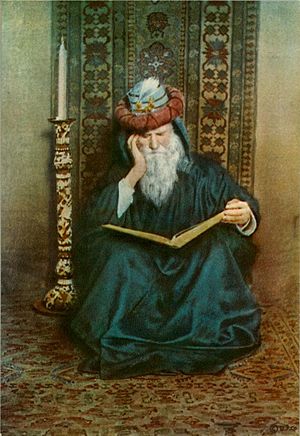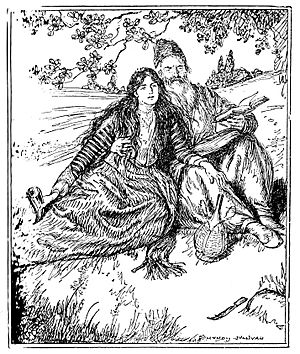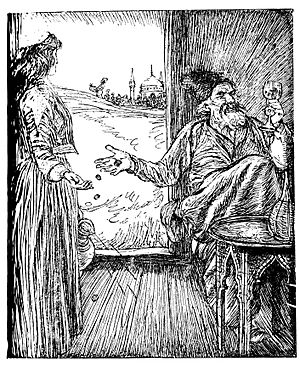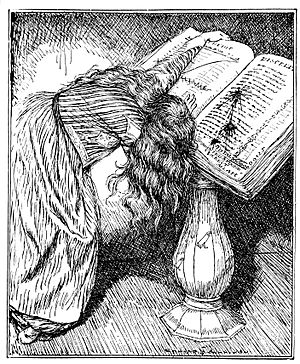Rubaiyat of Omar Khayyam facts for kids
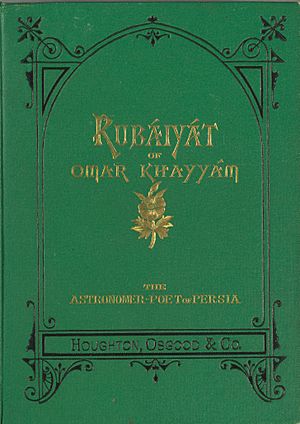
Front cover of the first American edition (1878)
|
|
| Author | Omar Khayyam |
|---|---|
| Translator | Edward FitzGerald |
| Genre | Poetry |
| Publisher | Bernard Quaritch |
|
Publication date
|
1859 |
| Text | Rubáiyát of Omar Khayyám, the Astronomer-Poet of Persia. Rendered into English Verse at Wikisource |
The Rubáiyát of Omar Khayyám is a famous collection of poems. It was translated from Persian into English by Edward FitzGerald in 1859. The poems are called quatrains, which are four-line verses. They are believed to have been written by Omar Khayyam (1048–1131). He was known as "the Astronomer-Poet of Persia."
At first, FitzGerald's book was not very popular. But after 1861, it became well-known, especially among a group of artists called the Pre-Raphaelites in England. By the 1880s, the book was extremely popular. People even started "Omar Khayyam clubs" because they loved the poems so much.
FitzGerald's work has been printed hundreds of times. It has also inspired many other translations into English, Hindi, and many other languages around the world.
Contents
Who Wrote the Poems?

It's not completely certain if Omar Khayyam wrote all the poems in the Rubaiyat. During his life, Khayyam was famous as an astronomer and mathematician, not as a poet. The first mention of him writing poetry was 43 years after he died. Other historians from the Middle Ages also supported this idea.
Some parts of the Rubaiyat appear as small quotes in older books and collections. However, many scholars are unsure about how many poems Khayyam actually wrote. Some believe the entire collection might have been written by others using his name.
Many of the old handwritten copies of the poems were made long after Khayyam lived. This makes it hard to know which verses are truly his. In the 1930s, some experts tried to find the real poems by looking at quotes from the 13th and 14th centuries. But this work was made harder by two clever fake manuscripts. Today, some scholars still think it's very difficult to know for sure which poems are truly Omar Khayyam's.
One expert, Sadegh Hedayat, noticed that the poems in later collections had many different ideas and styles. He said that it would be hard for one person to have so many different thoughts. He believed only 14 quatrains could be definitely linked to Khayyam. Another expert, Arthur Christensen, thought that out of over 1,200 poems, only 121 were likely real.
FitzGerald's translation was based on two manuscripts. His friend and teacher, Edward B. Cowell, sent him copies of these in 1856–57. FitzGerald finished his first draft in 1857. He printed 250 copies of a revised version in 1859. This first edition became very popular later on. By the 1890s, over two million copies had been sold.
What Do the Poems Mean?
FitzGerald's popular translation led to a big discussion about what the poems truly mean. FitzGerald believed Omar Khayyam's poems showed a lot of doubt about religion. In his introduction, FitzGerald said Omar's ideas were about enjoying life. He also claimed that Omar was disliked by the Sufis, a group of mystics, because Omar made fun of their practices.
Some experts agree that Khayyam was not liked by many Sufi leaders. They saw him as a scientist who thought freely, not as a fellow mystic. This idea is supported by a medieval historian named Al-Qifti. He wrote that Omar's poems seemed like Sufi poems on the outside, but they actually had anti-religious messages. He also said that Khayyam was accused of not being religious and went on a trip to avoid punishment.
However, other people criticized FitzGerald. They said he misunderstood the mystical side of Sufi poetry. They believed he took the poems too literally. These critics argued that Omar Khayyam's poems should be seen as having deeper, hidden meanings. They thought that talking about enjoying life in the poems was a way to talk about spiritual ideas.
Most scholars today agree with FitzGerald's view that the poems show doubt. They believe that understanding Khayyam as a Sufi requires reading a lot into his poems. Sadegh Hedayat, a modern scholar, also supported the idea that Khayyam's philosophy was about questioning things. He believed that when Khayyam mentioned "wine" in his poems, he meant real wine. He thought Khayyam used wine to deal with his sad thoughts and fears about the universe.
Different Versions of the Book
FitzGerald published his translation in five different editions. He made many changes to the poems in each new edition:
- 1st edition – 1859 (75 quatrains)
- 2nd edition – 1868 (110 quatrains)
- 3rd edition – 1872 (101 quatrains)
- 4th edition – 1879 (101 quatrains)
- 5th edition – 1889 (101 quatrains)
The fifth edition was published after FitzGerald passed away. It included small changes he had planned. Many more editions have been published since 1889. Some famous ones include illustrations by artists like Willy Pogany and Edmund Dulac. By 1929, over 300 different editions of the Rubaiyat had been printed.
How FitzGerald Translated the Poems
FitzGerald's translation uses rhymes and a rhythm, but it's not a word-for-word translation. He often rephrased the verses, and some parts cannot be found in his original source material. Some people even say that FitzGerald's Rubaiyat is more like his own original poetry, inspired by Omar's quatrains, rather than a strict translation.
Other Translations of the Rubaiyat
Many other people have translated the Rubaiyat into English and other languages.
- English: Edward Henry Whinfield published English translations in 1882 and 1883. John Leslie Garner also published a rhyming translation in 1888. Justin Huntly McCarthy created a prose translation in 1889. Richard Le Gallienne made a verse translation in 1897. Edward Heron-Allen published a prose translation in 1898. Jessie Cadell's translation was published after she died in 1899. In 1967, Robert Graves and Omar Ali-Shah published a translation that caused some debate because the original manuscript they claimed to use was never shown. Peter Avery and John Heath-Stubbs published a more literal English version in 1979. The first translation by an Iranian, Karim Emami, was published in 1988. Ahmad Saidi also translated 165 quatrains in 1991, focusing on keeping the original meaning.
- German: Adolf Friedrich von Schack published a German translation in 1878. Friedrich Martinus von Bodenstedt published another German translation in 1881.
- French: The first French translation was made by J. B. Nicolas in 1867. A well-known French version is by Franz Toussaint, published in 1924. He translated directly from the Persian text.
- Russian: Many Russian translations have been made. The earliest verse translation was in 1891. Osip Rumer translated FitzGerald's version in 1914, and later translated directly from Persian.
- Other Languages: The Rubaiyat has been translated into many other languages, including Afrikaans, Albanian, Arabic, Armenian, Belarusian, Bengali, Catalan, Chinese, Cornish, Czech, Dutch, Estonian, Finnish, Galician, Greek, Hindi, Hungarian, Icelandic, Irish, Italian, Japanese, Jèrriais, Kannada, Kurdish, Latvian, Malayalam, Odia, Polish, Romanian, Sanskrit, Scots, Serbo-Croatian, Slovene, Sureth, Swahili, Swedish, Syriac, Tagalog, Telugu, Thai, Welsh, and Vietnamese.
How the Rubaiyat Influenced Culture
FitzGerald called Omar Khayyam "Omar the Tentmaker." This name became popular in English-speaking culture for a while. There were novels, plays, and even a silent film called Omar the Tentmaker.
FitzGerald's translations also helped Iranians rediscover Khayyam's poetry, which they had not paid much attention to for a long time.
Literature and Stories
The Rubaiyat has inspired many books and stories:
- The title of the mystery novel Some Buried Caesar comes from one of FitzGerald's poems.
- The play Ah, Wilderness! gets its title from a line in the Rubaiyat.
- The mystery writer Agatha Christie used "The Moving Finger" as a story title.
- The science fiction novel The Throne of Saturn takes its title from a quatrain.
- The novel The Chequer Board also gets its title from the poems.
- The writer Hector Hugh Munro used the pen name 'Saki' from FitzGerald's translation.
- Oliver Herford wrote a funny version called "The Rubaiyat of a Persian Kitten."
- The Argentinian writer Jorge Luis Borges wrote about the Rubaiyat in his essays and poems.
- The science fiction writer Isaac Asimov quoted from the Rubaiyat in his novel The End of Eternity.
- The comic strip creator Charles M. Schulz had Lucy and Linus from Peanuts discuss a passage from the poems.
- The Lebanese writer Amin Maalouf based his novel Samarkand on Omar Khayyam's life.
- The title of Daphne du Maurier's memoir Myself when Young is a quote from the Rubaiyat.
- Rudyard Kipling wrote a funny poem called The Rupaiyat of Omar Kal'vin.
Movies and TV Shows
The Rubaiyat has also appeared in films and television:
- Filmmaker D.W. Griffith planned a film based on the poems in 1916.
- Lines from the Rubaiyat were used in the silent film A Lover's Oath (1925).
- A quote appeared in the 1926 film Torrent starring Greta Garbo.
- Part of a quatrain was quoted in the 1938 movie Algiers.
- A poem was used as a theme in the 1945 film The Picture of Dorian Gray.
- The Rubaiyat was quoted in the 1946 Western film Duel in the Sun.
- The 1951 film Pandora and the Flying Dutchman opens with a quote from the poems.
- In the film The Music Man, a character mentions the "Ruby Hat of Omar Kayayayayay" and its "dirty Persian poetry."
- The film Omar Khayyam (1957) includes parts of the Rubaiyat.
- In Back to the Future, a character is holding a copy of the book.
- The Rubaiyat was quoted in the 1995 film 12 Monkeys.
- In the TV show The Rocky and Bullwinkle Show, Bullwinkle finds the "Ruby Yacht of Omar Khayyam."
- In Have Gun - Will Travel, an episode is titled "The Bird of Time," quoting from the Rubaiyat.
- A copy of the Rubaiyat inspires a character's child's name in the TV series New Amsterdam.
Music
The poems have also inspired music:
- British composer Liza Lehmann set parts of FitzGerald's translation to music in 1896.
- Another British composer, Granville Bantock, created a choral piece based on the translation (1906–1909).
- The American composer Arthur Foote wrote piano and orchestral pieces inspired by the quatrains.
- The Egyptian singer Umm Kulthum recorded a song called "Rubaiyat Al-Khayyam" in 1950.
- Woody Guthrie recorded an excerpt of the Rubaiyat set to music.
- Elektra Records released a compilation album called Rubáiyát in 1990.
- The jazz-soul harpist Dorothy Ashby's 1970 album The Rubaiyat of Dorothy Ashby quotes from the poems.
- The famous "skull and roses" poster for a Grateful Dead concert was inspired by illustrations for the Rubaiyat.
- The song "Beautiful Feeling" by Paul Kelly includes lyrics from the poems.
- The musical Kismet (1953) features a character named Omar who recites lines from the Rubaiyat.
Other Interesting Facts
- In Australia, a copy of FitzGerald's translation and its last words, Tamam Shud ("Ended"), were important clues in the mystery of the Somerton Man.
- There was a real, jewel-covered copy of the book on the Titanic. It was made in 1911 and was being shipped to New York. Sadly, it was lost when the ship sank in 1912.
Anniversary Events
In 2009, people celebrated two important anniversaries: 150 years since FitzGerald's translation was published and 200 years since FitzGerald's birth. Events included:
- Art exhibitions, like "Elihu Vedder's Drawings for the Rubaiyat" at the Phoenix Art Museum.
- Exhibitions of rare editions, such as "Edward FitzGerald & The Rubaiyat" at the Grolier Club.
- A joint conference about Omar Khayyam, Edward FitzGerald, and the Rubaiyat at Cambridge University and Leiden University.
- The Folio Society published a special limited edition of the Rubáiyát.
See also
- Somerton Man


